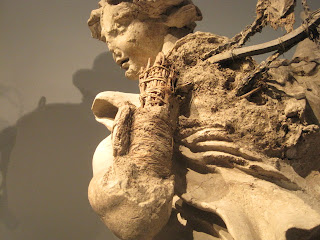 Angel on the Right 1673
Angel on the Right 1673Angel on the Right (final version)1665
Angel on the Left (final version) 1659-1660
Tabernacle in front of the Blessed Sacrament Chapel
Alter of the Chair of St. Peter
Artist: Gian Lorenzo Bernini
Location: Musei Vaticani, Rome
Medium: Clay, Straw, over an iron and wickerwork frame, vines tied together with twine, and numerous wooden elements.
Approximate dimensions of work: 20 x 10 ft.
Bernini constructed a group of model clay angels in preparation for his complete bronze sculptures for the Tabernacle in front of the Blessed Sacrament Chapel and the Alter of the Chair or Throne in St. Peter’s Basilica. These clay sculptures reveal the process and genius behind Bernini’s work. Due to the natural deterioration of the sculptures, the viewer can peer into Bernini’s mind and grasp how he formed the majestic beings from structuring them with iron, wicker framework, twine, wood, twigs, and dry grass before the clay was applied. The artist’s actual fingerprints and tool markings are imprinted within the breathe of the clay. The final products of these angels within the Basilica took Bernini 10 years to construct.
During the early 18th century, the altarpiece of St. Peter’s Basilica was St. Peter’s wooden chair, which was believed to have been the chair St. Peter sat in as he preached to the faithful citizens of Rome. Bernini was assigned by Pope Alexander VII to create an astounding monument to surround the chair in order to emphasize the chair’s value and importance. The two angels which stand on the arm rests of the chair are the final products of his clay models housed in the Vatican Museum.
The Blessed Sacrament Chapel Tabernacle was assigned to Bernini to construct in a manner that reflected a house of worship and reverence. The sign “Only those who wish to pray may enter,” is in front of the chapel entrance. The partaking of the Eucharist is enacted in the chapel, due to the sacred decorations that encourage viewers to pray in deep contemplation with Christ. Two angels kneel on either side of the Tabernacle to welcome the church into a time of prayer, reflection, and reverance. The angel on the right captures an expression more gentle than the angel on the left. The angel on the right portrays the “work of the Master” while the left embodies “the work of a helper” (1).
Angels in the Bible are supernatural beings who God created as heralds to deliver His people from darkness and to tell His story. God’s angels dwell amongst the Earth to protect God’s people through performing miracles of rescue and predictions. Stories in the Bible where angels have saved God’s people from persecution are Daniel in the Lions Den (Daniel 6), Peter liberated from Prison (Peter 12), Joseph fleeing Egypt (Matthew 2), Lot and his family rescued from Sodom and Gomorra (Genesis 19), and Jesus after being tempted in the wilderness for 40 days is attended by angels (Matthew 4). Stories in the Bible where Angels act as messengers are when the Angels visit the Shepherds to tell of the Birth of Christ, Gabriel tells Mary and Zechariah about their promised sons (Luke 1), and in a dream Joseph is informed that Mary will have a son (Matthew 1).
Bernini captures a divine and mystical presence within these clay models. Their expressions entrance the viewer to gaze upon the soft, comforting, yet fading faces. The Models are more evoking and compelling to gaze upon then the final products because of the vulnerability expressed. These sculptures transcend the precision and technicality involved within a work of art. It makes one wonder God’s process behind his design?
Personal Experimentation with Clay
Personal Experimentation with Clay

















No comments:
Post a Comment